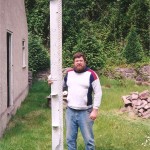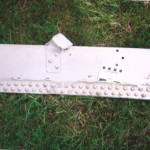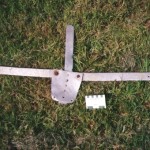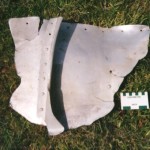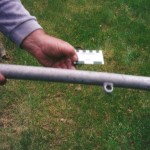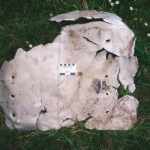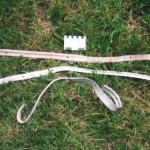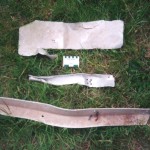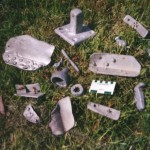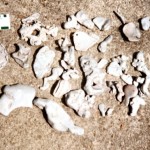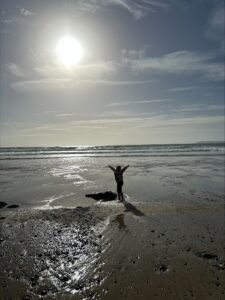The Aluminium Wreckage of Lindsway Bay Pembrokeshire
When our children were young, August spent in Pembrokeshire was very sunny and the winds blew from the south west. Lately for some years August has become the monsoon season and the winds blow from the south east and south and even the north. In those balmy years we established a holiday routine where our favourite day was spent on Lindsway Bay below the village of St. Ishmaels. We would load the car with beach things including a picnic and park at the Sports Club in St. Ishmaels village and then follow the path to the cliff line and turn left along the coast path to descend the steep steps down the cliff face onto Lindsway beach. In the evening after climbing back up the cliff with tired children and their beach treasures, we would have an excellent evening meal in the Brooke Inn in St. Ishmaels with hosts Hugh and Joan. Over the years we got to know the beach very well in all its different moods and states. At high tide there is really nothing there and the sea covers some of the large red sandstone boulders at the foot of the cliffs and steps. However at low tide a vast expanse of golden sand is exposed. At low tide there are really three beaches there and we called them Lindsway I -with the steps, Lindsway 2 to the immediate west (with a large cave for shelter from rain) and Lindsway 3 further west and separated by a finger of rocks and pools. All three beaches are sandy. At very low tide it is also possible to climb around the westernmost headland beyond Linsdsway 3 to another beach but there is no sand there only a rocky foreshore with a narrow pebble beach beneath the cliff. But it is a fine place of solitude with rock pools and sea birds.
Lindsway does not get crowded in the summer holidays like Sandy Haven beach which has a car park. There we had a series of favourite picnic spots but only on Lindsway 1 and 2, as at most states of the tide Lindsway 3 is a climb over the slippery rocky foreshore. We learned many things about the beach. At low tide at the east end of Lindsway 1 there is a shipwreck buried in the sand with a cargo of thick slates. For years we picked up fragments of the grey slate worn smooth by the sea action on the adjacent rocks and took some with us for the children to draw on. We also carved out some moulds in them and poured molten lead in them to make ornaments. One day and one day only on all our visits, the sand had been removed by the sea and the wreck was exposed. She must have been a wooden sailing ship but there was no wood left. Her cargo was intact being slates packed in boxfuls each with a herring bone pattern. The wooden boxes were gone but their contents were still in place being rectangles of “V” shaped thick slates stacked on end. They are still there today and probably exposed only once every 30 years.
The finger of rocky foreshore separating Lindsway 2 and 3 was of great interest to our children because of the large rock pools there. They spend many happy hours there with shrimping nets catching crabs and shrimps and after a family “show and tell” session returned them. At low spring tide its possible to walk on sand around the bottom of these rocks to get to Lindsway 3. Over several years I noticed the end of a large aluminium spar protruding out of the sand into one of these pools at the bottom of the rocks. I tried pulling it but it was firmly buried. However one year the sand cover was largely removed and I was able to lift it out of the sand. It was a long thick aluminium spar measuring 3m long by 18cm wide by 13mm thick (see photo). Despite being aluminium it was very heavy. Riveted along both sides were torn remnants of aluminium plates. I was entirely mystified as to what it was. My first conclusion was that it might be part of the wreck of a crashed Sunderland or other flying boat as they had been based at Pembroke Dock (further up the Milford Haven Waterway) throughout World War II and long afterwards. As a schoolboy in Milford Haven during the 1950’s the Sunderland flying boats passing over the town were a common sight. The Royal Air Force had a flying boat base in Pembroke dock from 1931 until 1957 and in 1943 it was the largest Sunderland base in the world.
So I washed the sand off the spar and was mystified to see remnants of aluminium plates riveted with aluminium studs to it. So I carried it up the beach to our picnic spot on my shoulder. It was very heavy. When my wife saw it she asked what I was going to do with it. I said I was getting to the bottom of the mystery so I would take it up the cliff and store until I could find out what it was. She became angry with me and said that if I climbed up the cliff with it I would probably have a heart attack. I did not think so but I thanked her for a good marriage and the children, kissed her goodbye and set off. It was a tough climb and at the top of the steps my shoulder was dented. So I turned east and followed the coast path onto the dirt road leading to the lighthouse on Great Castle Head (where our friend “Ron the Light” and his wife Mary lived) and dropped it there to collect by car. Clearly it was a case of the BGIS approving my action. For some geologists who batter around the world a lot and experience the wilderness areas, we have learned that our tiny fragile bodies and tiny ambitions are governed by what we call “The Big Geologist in the Sky (The BGIS)”.
Over the next few summers I scoured all three Lindsways and found a large assortment of aluminium wreckage but nothing remotely as big as that first spar. I found aluminium plates, struts, beading, a small cleat, coiled wire and a door knob on Lindsways 1, 2 and 3 (see photos). Battered and torn thick metal plates (originally measuring more than 75cm by 67cc and 2 and 3mm thick) were trapped under large boulders on Lindsway 3 and usually buried in sand and rarely visible. I spent some time with long lengths of driftwood lifting these boulders to ease out the battered sheets from underneath. In the pebbles making up the top of Lindsway 3 (and immediately below the point where the track from St Ishmaels Sports Club field joins the coast path and there is now a seat) I found many water rounded droplets of aluminium showing that the wreck had burned. These are shaped just like large gold nuggets and perhaps I should spray then with gold paint and sell them as fake fold nuggets. Some of the struts had numbers stamped on them. Some plates show remnants of paint coatings coloured pale green, and some struts remnants of red and blue.
All these things I carried away and stored in the garage at The Anchorage. I recorded and photographed and wrote a report (including part numbers) about them. A copy was sent to the Receiver of Wreck who opened an Admiralty droit number 069/93/94. Other copies were sent to the Coastguard, Pembrokeshire Aircraft Heritage Society, and the Hydrographic Office of the Ministry of Defence. A lot of correspondence and paperwork resulted but no positive identification was made, nor ownership found. No definite identification could be made but the Hydrographic Office and Aircraft Heritage were of the opinion that the wreckage was not of aircraft origin as it was too thick, although Sunderlands could not be entirely eliminated. The Hydrographic Office raised the possibility that it might have originated from the scrapping of any “Ton” class mine countermeasure vessels in the area as they had aluminium superstructure. After a year (1995), as no owner could be found, the droit was closed and the Receiver of Wreck awarded the wreckage to me in lieu of costs of recovery and storage. I still have it today and am still trying to fully solve the puzzle of its origin.
And what an interesting puzzle it has been extending over many years now. The supply of wreckage soon dried up. So the jigsaw puzzle is incomplete. Reading has produced some time constraints for the wreckage. Aluminium was first produced commercially in 1854 when it was too costly to be widely used. A new process in 1889 brought the metal into wide commercial use. In 1894 a Scottish ship building yard built the first aluminium ship being a 58m motor torpedo boat named “Falcon” for the navy of the Russian Empire. In 1895 the cost of aluminium was 35 times that of steel. By 1914 the cost was so reduced that it was no longer regarded as a precious metal. So the wreckage should be younger than 1914. Another time constraint is given by the fact that the Lindsway wreckage lacks welding and is riveted together. This suggest than it is older than when aluminium welding was first carried out in 1944. So there is a time frame of 1914 to 1944. A visit to the Sunderland museum in Pembroke Dock produced a surprising result. There pieces of a sunken Sunderland are on display that were recovered after 50 years under the haven waters. The aluminium is deeply pitted and corroded. The wreckage from Lindsway Bay lacks this corrosion and if it is not an alloy, then it has been in the sea for a much shorter time than 50 years.
I read about the World War II crashed aircraft in the area. There were several Catalinas and Sunderland aircraft that tried to return to their base in the Pembroke Dock in war damaged condition that crashed within and around the waterway. One had even crashed on Milford Docks and burned and the townspeople of Milford Haven (including my family) remember the cries of the crew in the quiet of the night. I studied photographs of the interiors of these aircraft. But none of the parts were anything like the parts of a flying boat, so that possibility was eliminated. Next I learned that during World War I ships in the Irish Sea had been accompanied by dirigibles (sausage-shaped balloons) with a crewed aircraft fuselage with engine suspended underneath. This proved more promising but was discarded because of the thickness and weight of the pieces recovered. Photographs of airship frames did not match either. I even discovered that during World War II an aircraft carrier had been anchored off Lindsway Bay for some time and it was possible that parts had been thrown overboard. Finally I was forced to agree with the observations of the Hydrographic Office that the big strut and thick aluminium plates indicated that the source was an aluminium boat or ship. The big strut seems to have been the bow or stem of the boat as it has some deep dents on what would have been the leading edge where the metal plates have a double row of thick aluminium rivets suggesting extra strength such as the bow of a launch.
Two critical clues are some pieces of aluminium wire and the presence of rusty iron plates under some of the boulders on Lindsway 3. The aluminium wire had been carefully coiled. This would not be the case in a wreck. The metal plates on Lindsway 3 are similar to metal plates on Watwick beach near the entrance to the waterway. I know the origins of those on Watwick as they are all that remain of a steel barge that washed ashore and was wrecked there in a storm in the 1960s. My present conclusion is that the aluminium wreckage on Lindsway beach was a load of scrap aluminium derived from a loaded barge that was wrecked on the rocks between Lindsway 2 and 3. Strangely this same finger of rocky shore was also the site of the stranding of the tanker Dionna Marika in 1973. There are two possible sources for a barge full of aluminium wreckage of a boat. One possibility is the Wards Ship Breaking Yard that operated on the shore below Milford Haven from 1934 to 1956. However their scrap metal was removed by railway from the yard. The other is the Royal Naval Dockyard in Pembroke Dock (1758 – 2008). The Royal Air Force had a station in the dockyard from 1931 to 1959 and in 1943 operated 99 Catalina and Sunderland flying boats with attendant launches. The dockyard is also a likely source for the aluminium wreckage.
It seems most likely that the scrap is from an aluminium launch or from the aluminium superstructure of a “Ton” class mine hunter. 115 of these small ships were built for the Royal Navy between 1952 and 1959 and the first was scrapped in 1970. Happily one of them still survives and has been a museum ship since 1989. She is HMS Brontington launched on 11th June 1953. These dates are not consistent with the closure date of Wards Yard in 1956, nor the fact that the metal was joined by riveting (pre-1944) but do agree with the lack of deep corrosion on the wreckage. Because of these inconsistencies I still keep the wreckage and still hope to better understand its origins. The next step is a visit to HMS Brontington where she is preserved by the Warship Protection Trust and berthed at Birkenhead. Perhaps today with the creation of the internet, somebody will recognise the wreckage.
